All painters soon discover that black is not black. Black is, like any color, a general term used to describe a large range of colors. We have three blacks in our Heavy Body, Fluid and OPEN Acrylics: Carbon Black, Mars Black and Bone Black. While all three of these are nominally black, they are formed in different ways, are chemically different, and have quite different undertones. Carbon Black pigment is usually formed from partial combustion of natural gas and is a nearly pure form of carbon. It is the strongest of our blacks and has a slightly cool undertone. Bone Black, on the other hand, is formed from the burning of animal bones, where impurities provide a slightly warmer undertone. It is also the most translucent of the blacks. Mars Black, a synthetic iron oxide and the warmest, has a slightly brownish undertone.
There are many instances in painting when a dark color is needed or when we might see a surface or space that our brains are telling us is “black”. Of course, we could reach for one of the three black colors described above, or we could mix a black with compliments, such as Quinacridone Magenta and Phthalo Green (Blue Shade), which will give us a type of chromatic black, that we can then adjust to lean toward the magenta or the green. Our 4 new ‘Experimental’ Chromatic Blacks were created to provide just that type of adjustment. These experimental colors all start with Carbon Black to which we add small amounts of translucent organic pigments to give them a subtle tilt toward a certain hue. As with most of our regular colors, there are no fillers or matting agents added, so the dry surface sheens have a natural variation due to pigment load. The Chromatic Black Blue and Chromatic Black Green are both a bit glossier than the other three Blacks, which tend to have a more satin or semi-gloss surface.

Chromatic Black Red (CBR) and Chromatic Black Yellow (CBY)
These two warm toned Chromatic Blacks appear ever so slightly lighter in value than our Carbon Black, which is the comparison standard I am using. But, it is the color or hue difference that creates most, if not all, of the visible difference when placed side by side. CBR and CBY both appear very similar in mass tone, looking subtly warm, and even a little brownish. It is only when you spread the paint out thinly and add water to make a wash, or medium to create a glaze, that you see the more obvious color lurking in the dark. The CBR is the warmest looking in the undertone, while the CBY takes on a bit of a Sap Green tone and feels cooler. The CBR uses Naphthol Red Light and the CBY contains Nickel Azo Yellow.(CBY)
Chromatic Black Blue (CBB) and Chromatic Black Green (CBG)
The CBB and CBG are both darker in value than the red and yellow blacks, with the CBB being the darkest value of them all. It is actually darker in value than the Carbon Black. Both are quite cool, with the blue being the coolest. Paynes Gray can be thought of as a kind of chromatic black, since it is made with Carbon Black and Ultramarine Blue, but the ratio of pigments leans much more heavily with the blue component, giving the color a very distinct blue undertone, along with a clearly perceivable blue in the masstone. The CBB, which is also Carbon Black blended with a blue pigment has a much less pronounced blue undertone, is more neutral in color and darker in the masstone, appearing as a very cool, dark, rich black. The blue pigment used is Anthraquinone Blue, a very dark and red leaning blue. Chromatic Black Green is second in line to the CBB in darkness of value, appearing somewhat warmer in the masstone. Phthalo Green (Yellow Shade) is added to create the green coloration, and is cooled down quite a bit from the very cool carbon black.
These Chromatic Blacks can be very useful when you need to paint a dark passage that needs to read as a color, rather than a cold black. Of course, you can also mix with white to make an infinite array of chromatic grays, or blend in mediums for translucent chromatic gray glazes. Try adding just a touch of any Iridescent color to that glaze and watch to see what happens. Sure, Manet could make dense Bone Black work as a color, but in most cases a specific chromatic black is needed. Here they are, waiting for you. Don’t be afraid of the dark.
Clear Pouring Medium (Thin)
Clear Pouring Medium (Thick)
Over the last decade or so we have been fielding regular questions in Technical Support Services about how to achieve what has very loosely been described as the “resin look” on the surface of acrylic paintings. It started with artists using industrial grade two part epoxy resins on their paintings, which were typically on rigid panels, since this type of epoxy resin is usually pretty hard and inflexible. In tests we have seen them yellow from exposure to UV light, and the compounds are known to be fairly toxic. Our new Clear Pouring Mediums have broken tradition with the inflexibility and toxicity of epoxy resin and with all pouring mediums made with acrylic that have come before them. They are truly clear in the wet state.
At present we offer two types: Thin and Thick. Both are long rheology in consistency, and level out very nicely. What this means is that they have a very syrupy consistency like molasses or honey, so tool marks will tend to melt away as the product settles out. At first look, they might seem very close to the same consistency, but if you poured out a puddle of each and then tilted the panel, the Thin one would run down the panel twice as fast as the Thick version. The Thick one can be used to create what we often call “pancake” pours, while the Thin type will tend to flow out and create a thinner film that would probably be better for applications where a relatively thin, clear, smooth and glossy coating is required over the entire surface of the work. Both are good at releasing air bubbles, and the Thin type is virtually bubble free when poured directly from the container with minimal manipulation. At this time, these mediums come in gloss sheen.
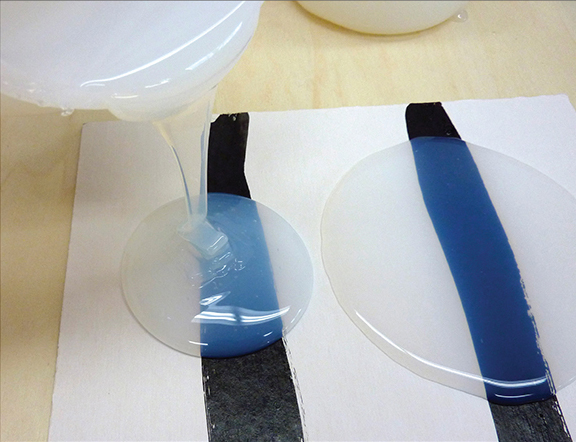
These Clear Pouring Mediums are waterborne acrylic urethanes, very translucent in the wet state and dry to very clear, flexible films. This is very different from the catalytic curing process of two part epoxies, which harden and cure due to chemical interactions, rather than evaporation of water, so they are compatible with our whole range of waterborne acrylic paints and mediums.
We conducted the same level of UV light testing that we put all of our products through, and these Mediums came through with flying colors. They had fewer changes as compared to most of our Mediums and Gel Mediums, and retained much of their clarity. The dry films have about the same level of flexibility as our standard paints and mediums, but in testing they were more block resistant. They will still imprint and ferrotype if left pressed against another surface, but less so than our standard acrylics. These attributes make them better as a topcoat for fine art. One possible use that we are excited about is for floor cloths, where the combination of physical durability and flexibility is important. It is important to note that they will not have the physical hardness of polyurethane and should not be used for a topcoat on functional objects.
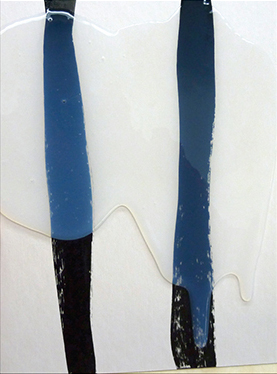
when tilted, showing viscosity differences.
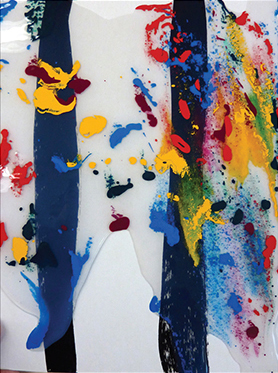
Mediums, demonstrating clarity of material.
Any instance where a fine art grade, clear, glossy, less tacky and very smooth coating is desired on an acrylic painting, these Clear Pouring Mediums can work well. They can also be used as painting mediums, blended with our Fluid or Heavy Body colors, and their high translucency in the wet state enables techniques not possible with a standard acrylic medium, since you can see the different layers of color moving inside the liquid medium as you work with it. For many artists this may be the most exciting attribute. Be on the lookout for these products at select retail locations beginning in June.
We would still advocate packing, storing and shipping any acrylic painting with nothing touching the surface. For more information about proper handling of acrylic paintings, here are previous articles from our Just Paint Newsletters and the Canadian Conservation Institute:
- Safe Handling and Transportation of Acrylic Paintings
- The Canadian Conservation Institute – How to Wrap a Painting for Shipping
http://www.cci-icc.gc.ca/resources-ressources/ccinotesicc/10-16-eng.aspx
For more information about changes that typical acrylic mediums can incur over time, refer to these Just Paint articles:
- Defining The Acrylic Patina
- Guidelines for Clear or Lightly Tinted Textures, Layers, and Glazes
http://www.goldenpaints.com/technicalinfo/technicalinfo_clear_layers
Thick Self Leveling Gel (TSLG)
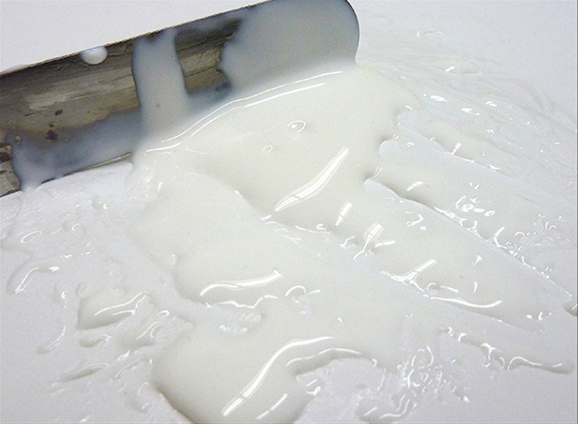
losing all tool marks.
Another name for this Gel Medium could have been “the incredible melting gel”. The easiest way to describe its consistency and working properties is to compare it to how corn starch and water react as a mixture, or to the way Silly Putty® can flow when at rest, but will break when suddenly shocked or pulled apart. Materials that behave like this are called shear thickening fluids. When at rest, it looks like it could be a very liquid material, as the surface is very smooth, but you can completely invert the container and the Gel will barely move. With some movement of the container, the Gel can be poured very slowly, but it will do so in a thick and very long, stringy mass. These characteristics can make it a little challenging to use initially, but they also open up a world of possibilities.
When you dip a palette knife or other tool into the smooth surface and move it around, it stiffens up immediately and takes on a rougher, “cottage cheese” like texture due to the sudden viscosity change. It will hold tool marks initially for a very short period, but just as quickly, those tool marks begin to melt away as the Gel begins to level out. After several minutes, most texture or tool marks will have completely disappeared.
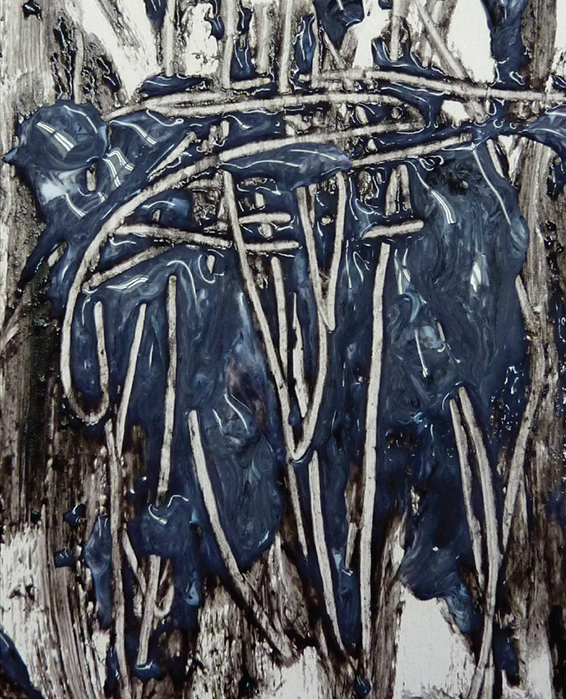
possible to achieve with Thick Self Leveling Gel.
One interesting technique involves brushing out a blend of TSLG and a little Fluid Acrylic or Heavy Body Acrylic. As you move the mixture on a surface, it thickens and you can easily create grainy looking, dry brush effects and sgraffito marks. When you stop and allow the mixture to relax, the thicker areas will settle out, adopting a very smooth and rounded texture, but the dry brushy and sgraffito marks will remain. It’s an effect that would be very hard to get with any other medium or paint.
Unlike our Clear Pouring Mediums, this Gel is quite white and opaque when wet, similar to most other waterborne acrylic mediums, but will dry glossy and translucent. It will have the same potential for changes in color over time that all standard Gels and Mediums have, as outlined in the ‘Acrylic Patina’ article listed above.
As with all Experimental Products we develop, we welcome your feedback. Just call Technical Support Services at 607-847-6154.
About Scott Bennett
View all posts by Scott Bennett -->Subscribe
Subscribe to the newsletter today!
No related Post
